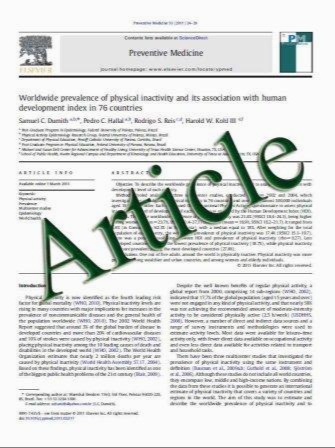Aromatase immunoreactivity is increased in mammographically dense regions of the breast
- نوع فایل : کتاب
- زبان : انگلیسی
- مؤلف : Celine M. Vachon Hironobu Sasano Karthik Ghosh Kathleen R. Brandt David A. Watson Carol Reynolds Wilma L. Lingle Paul E. Goss Rong Li
- چاپ و سال / کشور: 2010
Description
Mammographic breast density (MBD) is one of the strongest risk factors for breast cancer. Unfortunately, the biologic basis underlying this association is unknown. This study compared aromatase expression or immunoreactivity (IR) in core biopsies from mammographically dense versus non-dense regions of the breast to examine whether estrogen synthesis in the breast is associated with MBD and one possible mechanism through which MBD may influence breast cancer. Eligible participants were 40? years, had a screening mammogram with visible MBD and no prior cancer or current endocrine therapy. Mammograms were used to identify dense and non-dense regions and ultrasoundguided core biopsies were performed to obtain tissue from these regions. Immunostaining for aromatase employed the streptavidin–biotin amplification method and #677 mouse monoclonal antibody. Aromatase IR was scored in terms of extent and intensity of staining for each cell type (stroma, epithelium, adipocytes) on histologic sections. A modified histological H-score provided quantitation of aromatase IR in each cell type and overall. Repeated measure analyses evaluated average differences (bH) in H-score in dense versus non-dense tissue within and across cell types. Forty-nine women with mean age 50 years (range: 40–82), participated. Aromatase IR was increased in dense (vs. non-dense) tissue in both the stroma (bH = 0.58) and epithelium (bH = 0.12) (P\0.01). Adipocytes from non-dense tissue, however, had a greater IR compared to those from dense tissue (bH = -0.24, P\0.01). An overall H-score which integrated results from all cell types demonstrated that aromatase IR was twice as great for dense (mean H-score = 0.90, SD = 0.53) versus non-dense (mean H-score = 0.45, SD = 0.39) breast tissue (bH = 0.45; P\0.001). Overall, aromatase IR was greater for mammographically dense versus non-dense tissue and may partly explain how MBD influences breast cancer.
Breast Cancer Res Treat (2011) 125:243–252 DOI 10.1007/s10549-010-0944-6 Received: 6 March 2010 / Accepted: 8 May 2010 / Published online: 5 June 2010


